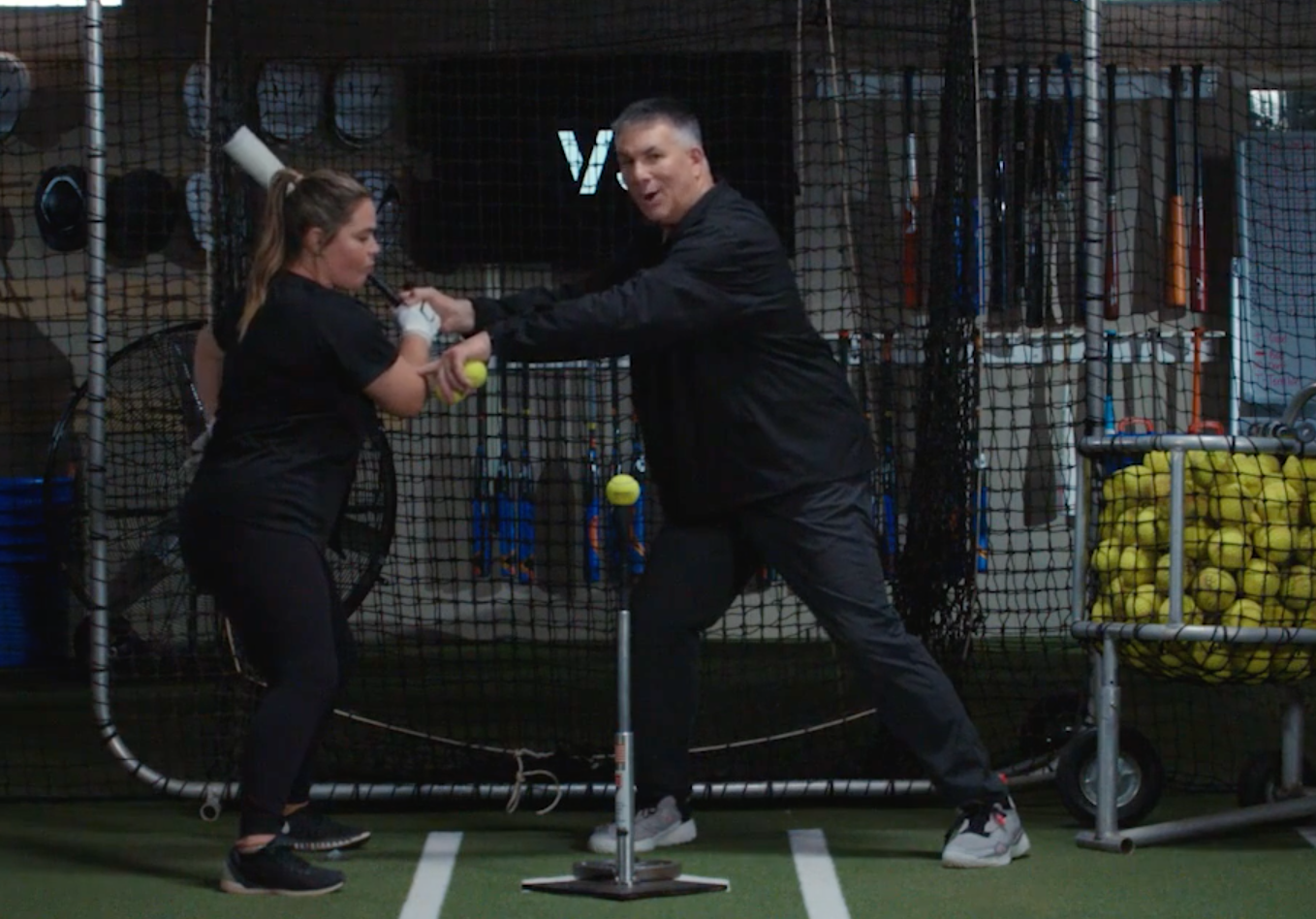Developing Into a Power Hitter

What every aspiring big hitter MUST know. When it comes to hitting, every player in softball and baseball needs to be able to create and direct power.
Developing Into a Power Hitter
What every aspiring big hitter MUST know.
When it comes to hitting, every player in softball and baseball needs to be able to create and direct power.
Getting a good amount of power behind the ball isn’t the only skill required at bat—but it is one of the most important.
Accuracy, timing, and aiming the ball play a role in hitting. But without power, these alone won’t achieve the desired result.
The challenge with power hitting is in deciding whether or not to swing for the fences. In those cases, sometimes proper batting form goes out the window.
This creates a result where the hitter gets lucky here and there, but has trouble consistently backing up solid performances at bat.
If you want to develop into a hitter that makes the starting line-up, you need to learn the fundamentals of power hitting—the right way.
To help us out with this, we asked world-renowned softball coach Tim Walton, to film an exclusive training session on how to develop into a power hitter.

Why Tim Walton?
There aren’t many coaches still in the game with Tim Walton’s depth of experience.
As a baseball player, assistant softball coach, and head softball coach of the Florida Gators for years—Tim has a reputation for consistently producing winning teams and athletes.
He led the Gators to a Southern Conference-leading ninth regular season title in 2021, on top of Florida winning the SEC Regular Season Title five of the last six seasons. In May 2022, Walton reached his 1000th career win, becoming the second fastest NCAA coach to achieve such a feat.
And while he’s definitely known for producing winning teams—Tim’s no slouch when it comes to developing league-leading individual athletes.
Under his leadership, Gator student-athletes have collected:
- 46 NFCA All-American accolades
- 67 All-SEC honors
- 2 x USA Softball Player of the Year honorees
- 3 x Honda Award winners
- 10 x SEC Player & Pitcher of the year
Walton coached and mentored Versus athlete Amanda Lorenz—regarded as one of the greatest hitters to ever play the game of softball.
What you’ll notice in this training session of Tim’s (and all of his others), is he goes well beyond surface-level in every topic he teaches. Walton doesn’t just run through a skill in isolation. He explains theory, practical application, and how the skill fits with every aspect of the game.
This caliber of coaching is rare. And quite frankly—out of the reach of most athletes.
But don’t worry, we can help.
The Versus platform makes instruction from world-class coaches and elite athletes available to everyone.
With a subscription to Versus, you’ll have access to a full library of personalized content from coaches the likes of Tim Walton and Jennie Finch. Plus league-leading athletes, like Amanda Lorenz, Adam Wainwright, and Albert Pujols.
This star-studded roster covers everything you need to know to achieve your full sporting potential. From skills work and training tips. Mindset. Even building your personal brand.
We’ve created this article from Tim Walton’s exclusive video session on becoming a power hitter.
While you’re sure to learn some valuable tips reading through, to get the full experience—head over to Versus to sign up and watch him in action.
There’s a package to suit everyone’s needs, including a free trial option to see if Versus is for you.
Ok. Let’s get into Tim Walton’s guide to developing into a power hitter.
Avoid “Fake Power”
The first piece of advice Walton gives aspiring big hitters, is to avoid “fake power.”
When trying to get more force behind the ball, many players resort to creating artificial length in their swing through body positioning. Think, leaning back, tilting to one side, or any unnecessary body movement.
This can sometimes have the desired effect—but it’s not an accurate or consistent way to hit.
Athletes who rely on “fake power” are not in control of their swing. They’ll get lucky on occasion. But will never develop the consistency at bat to reach higher levels of competition.
A good pitcher will easily see where the batter is compensating for a lack of technique, then capitalize on this weakness.
To develop real power—practice creating length with a compact swing that impacts the ball at a good launch angle—while maintaining solid body positioning.
One way to practice this, is with a “cast stick” during tee work, as pictured below:

The cast stick is a secondary tee placed just outside home plate. It signals to the player (and coach) when power is created by an artificially lengthened swing.
Power needs to stay directly over the home plate. And the goal all hitters should aim for, is a compact swing with an accurate launch angle.
This ensures length comes from proper barrel positioning and swinging mechanics—not excessive body movement.
Here’s what real power looks like in action.

Dial in Your Swing
When it comes to power hitting, barrel positioning is the most important aspect of a swing.
Walton’s main advice is—keep your barrel back to be in control.
Here are a few positioning cues for different stages throughout the swing:
Start with the barrel slightly behind the head.

Keep the barrel behind the hands throughout the swing.

Barrel should be slightly below the hands through the second half of the swing.

To train keeping your barrel back, Tim recommends practicing one-handed swings with a tee-ball bat (from a tee or soft toss).
This drill can take a bit of getting used to. Even with the lighter bat, it’s common for hitters to be uncoordinated using one hand. Cranking the swing with excess body movement is the main error to watch out for.
Here’s what maintaining good body and barrel positioning throughout the drill looks like:

Understand What Creates Power
The upper body is important in hitting. But when it comes to actually creating raw power—the lower body does the heavy lifting.
Hands, arms, and shoulders ensure the bat stays in the right positions throughout the swing. While legs, hips and core generate the force needed to send the ball flying.
To become a power hitter, a player needs to create power in the lower body (also known as the posterior chain), then transmit this to the barrel.
This is the reason Tim focuses so much on body and barrel positioning.
If either one falls out of alignment, the hitter won’t be able to transfer anywhere near their maximum level of power to the ball.
To become more powerful at bat—always approach hitting with the entire body in mind.
Try to create as much energy as possible in:
The barrel.

Using the legs.
And the core.
In a straight direction.
To create the ultimate ball exit speed and launch angle.

Increase Grip Strength
As an athlete gets better at transferring energy from their posterior chain, it’s usually necessary to increase grip strength.
Strength in the hands and forearms must be sufficient to counterbalance force from the lower body. The more power generated from the posterior chain—the more grip strength required to maintain proper barrel positioning.
There are several training options to increase grip strength.
Walton recommends rice bucket drills. If you’re not familiar with these, a simple web search will give you tons of options.
He also suggests simple bat raises.

To perform a bat raise—using one hand at a time, keep your barrel in the same position as long as possible. This will improve finger, hand, wrist, and forearm strength.
In the weight room, farmer’s carries, deadlifts, and wrist curls are good options to increase grip strength. These can be performed with kettlebells, dumbbells, or a barbell (no straps, double overhand for barbell deadlift).
An old-school handheld grip trainer is also a good option if you’re serious about developing some superhuman grip!
Swing With Intent
The core message of Tim Walton’s guidelines for developing into a power hitter—is to always swing with intent.
Many big hitters start off relying on brute strength and inborn talent. They swing for the fences and hope for the best.
Particularly in junior and amateur leagues, some get good results with this approach.
But it never lasts.
Inevitably, players that don’t develop their foundational skills as a power hitter, never perform consistently. They’ll have a hot streak here and there—but can’t back it up.
Furthermore, once their opponents wise up to their shortcomings, the hitter’s weaknesses get exploited, and their performance tanks.
To make it to the big leagues, a hitter has to learn how to swing with intent.
Fortunately, Tim Walton has laid out a comprehensive plan for how to do this.
He provides a detailed set of cues, drills, and strategy—to help any athlete start the journey of developing into a power hitter.
As an added bonus, we’ll leave you to ponder two gems Walton casually throws out at the end of the video, without his characteristic attention to detail:
“If you’re going to be a really good hitter, you have to maximize power by minimizing the pitches you swing at.”
And;
“You’re not going to get a hit every time. But if you want to be a power hitter, you can’t be afraid to make mistakes.”
If you want to learn more about becoming a better hitter. And how to take the rest of your game to the next level. Head over to the Versus website and check out our Game Plans.
From a Free Trial to our Unlimited option, you can choose the type of experience, access, and participation you want.
Keep up with the Versus community.
Get notified of new content releases, new features, and much more!
Sign up to get new article notifications
Join our newsletter for new course release updates and get early access to upcoming course trailers.










